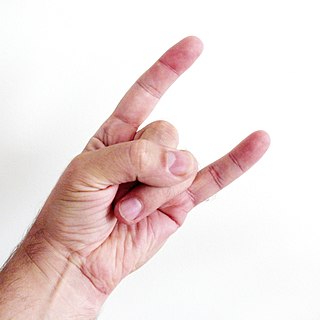
Rhetoric is the art of persuasion. It is one of the three ancient arts of discourse (trivium) along with grammar and logic/dialectic. As an academic discipline within the humanities, rhetoric aims to study the techniques that speakers or writers use to inform, persuade, and motivate their audiences. Rhetoric also provides heuristics for understanding, discovering, and developing arguments for particular situations.

In Western culture, "the finger", or the middle finger is an obscene hand gesture. The gesture communicates moderate to extreme contempt, and is roughly equivalent in meaning to "fuck you", "fuck me", "shove it up your ass/arse", "up yours", or "go fuck yourself". It is performed by showing the back of a hand that has only the middle finger extended upwards, though in some locales, the thumb is extended. Extending the finger is considered a symbol of contempt in several cultures, especially in the Western world. Many cultures use similar gestures to display their disrespect, although others use it to express pointing without intentional disrespect. The gesture is usually used to express contempt but can also be used humorously or playfully.

A gesture is a form of non-verbal communication or non-vocal communication in which visible bodily actions communicate particular messages, either in place of, or in conjunction with, speech. Gestures include movement of the hands, face, or other parts of the body. Gestures differ from physical non-verbal communication that does not communicate specific messages, such as purely expressive displays, proxemics, or displays of joint attention. Gestures allow individuals to communicate a variety of feelings and thoughts, from contempt and hostility to approval and affection, often together with body language in addition to words when they speak. Gesticulation and speech work independently of each other, but join to provide emphasis and meaning.

A mudra is a symbolic or ritual gesture or pose in Hinduism, Jainism and Buddhism. While some mudras involve the entire body, most are performed with the hands and fingers.

Much Buddhist art uses depictions of the historical Buddha, Gautama Buddha, which are known as Buddharūpa in Sanskrit and Pali. These may be statues or other images such as paintings. The main figure in an image may be someone else who has obtained Buddhahood, or a boddhisattva, especially in the various traditions of Mahayana Buddhism. Other Buddhas and bodhisattvas in art have become increasingly common over the centuries, perhaps now outnumbering images of the historical Buddha.

Hook 'em Horns is the chant and hand signal of The University of Texas at Austin. Students, alumni, and fans of the university employ a greeting consisting of the phrase "Hook 'em" or "Hook 'em Horns" and also use the phrase as a parting good-bye or as the closing line in a letter or story.

Pronuntiatio was the discipline of delivering speeches in Western classical rhetoric. It is one of the five canons of classical rhetoric that concern the crafting and delivery of speeches. In literature the equivalent of ancient pronuntiatio is the recitation of epics.

The OK gesture or OK sign or ring gesture is performed by joining the thumb and index finger in a circle, and holding the other fingers straight or relaxed away from the palm. Commonly used by scuba divers, it signifies "I am OK" or "Are you OK?" when underwater. In most English-speaking countries it denotes approval, agreement, and that all is well or "okay". In other contexts or cultures, similar gestures may have different meanings including those that are negative, offensive, financial, numerical, devotional, political, or purely linguistic.

The sign of the horns is a hand gesture with a variety of meanings and uses in various cultures. It is formed by extending the index and little fingers while holding the middle and ring fingers down with the thumb.
Gilbert Austin (1753–1837) was an Irish educator, clergyman and author. Austin is best known for his 1806 book on chironomia, Chironomia, or a Treatise on Rhetorical Delivery. Heavily influenced by classical writers, Austin stressed the importance of voice and gesture to a successful oration.

Pollice verso or verso pollice is a Latin phrase, meaning "with a turned thumb", that is used in the context of gladiatorial combat. It refers to a hand gesture or thumb signal used by Ancient Roman crowds to pass judgment on a defeated gladiator following duels in colloseums.

The Supper at Emmaus is a painting by the Italian Baroque master Caravaggio, executed in 1601, and now in London. It depicts the Gospel story of the resurrected Jesus's appearance in Emmaus.

In ancient Rome the Latin word adlocutio means an address given by a general, usually the emperor, to his massed army and legions, and a general form of Roman salute from the army to their leader. The research of adlocutio focuses on the art of statuary and coinage aspects. It is often portrayed in sculpture, either simply as a single, life-size contrapposto figure of the general with his arm outstretched, or a relief scene of the general on a podium addressing the army. Such relief scenes also frequently appear on imperial coinage.

John Bulwer was an English physician and early Baconian natural philosopher who wrote five works exploring the Body and human communication, particularly by gesture. He was the first person in England to propose educating deaf people, the plans for an Academy he outlines in Philocophus and The Dumbe mans academie.

The hand-in-waistcoat is a gesture commonly found in portraiture during the 18th and 19th centuries. The pose appeared by the 1750s to indicate leadership in a calm and firm manner, or allegiance to Freemasonry. The pose is most often associated with Napoleon Bonaparte due to its use in several portraits made by his artist, Jacques-Louis David, amongst them the 1812 painting Napoleon in His Study. The pose, thought of as being stately, was copied by other portrait painters across Europe and America. Most paintings and photographs show the right hand inserted into the waistcoat/jacket, but some sitters appear with the left hand inserted. The pose was also often seen in mid-nineteenth century photography.

Declamation is an artistic form of public speaking. It is a dramatic oration designed to express through articulation, emphasis and gesture the full sense of the text being conveyed.

The Death of Seneca is a 1773 oil-on-canvas painting by the French artist Jacques-Louis David, now at the Petit Palais in Paris. It shows the suicide of Seneca the Younger. With its Boucher-like assembly of gesticulating figures, it was his third attempt to win the Prix de Rome, but lost to a painting on the same subject by Pierre Peyron. Peyron's had fewer details and a darker colour palette and was closer to the 'antique'. He was not only David's rival, but also initiated the new classicism which partly inspired David to produce his 1774 Erasistratus Discovering the Cause of Antiochus' Disease.

A hand heart is a gesture in which a person forms a heart shape using their fingers.
Hand gestures are used in regions of Italy and in the Italian language as a form of nonverbal communication and expression. The gestures within the Italian lexicon are dominated by movements of the hands and fingers, but may also include movements of facial features such as eyebrows, the mouth and the cheeks. Theories persist as to the exact origin of hand gestures as a method of communication in Italy, however it is likely that they emerged through necessity as a universal, non-verbal method of communicating across different Italian local languages and dialects. Despite the majority of today's Italian population speaking Italian, hand gestures have persisted as a method of expression to accompany verbal speech in many regions of Italy.

















